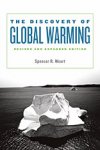- Joined
- Oct 23, 2015
- Messages
- 3,931
- Reaction score
- 1,260
- Location
- Oz
- Gender
- Male
- Political Leaning
- Undisclosed
"The Discovery of Global Warming" - Professor Spencer Weart.

The Discovery of Global Warming -Spencer R. Weart | Harvard University Press (an expanded online copy is available on the American Institute of Physics website.)
https://history.aip.org/climate/impacts.htm
https://history.aip.org/climate/author.htm
"A landmark study on "Man's Impact on the Global Environment," conducted at the Massachusetts Institute of Technology in 1970, suggested that greenhouse warming might bring "widespread droughts, changes of the ocean level, and so forth," but could not get beyond such vague worries.(5) A meeting in Stockholm the following year came to similar conclusions, and added that we might pass a point of no return if the Arctic Ocean's ice cover disappeared. That would change the world's weather in ways that the scientists could not guess at, but that they thought might be serious. Their main point in bringing up the Arctic ice, however, was simply to illustrate "the sensitivity of a complex and perhaps unstable system that man might significantly alter."(6)
Up to this point, scientists expected that greenhouse warming, if it happened at all, would bring no serious impacts until well into the 21st century. And the 21st century seemed so far away! But was climate change really so distant? In the early 1970's the world saw vivid illustrations of climate fluctuations as savage droughts afflicted the American Midwest, devastated the Russian wheat crop and brought starvation upon millions in Africa. Studies of climate were still in their infancy, and scientists were debating whether the greenhouse effect from CO2 emissions might be overwhelmed by the cooling caused by other forms of pollution. A few scientists speculated that industrial emissions of aerosols might cause severe cooling, while others suspected that natural cycles might bring a new ice age within the next few centuries. Nobody knew whether warming or cooling was more likely.
Studies of the impacts of climate change therefore tended to address generalities such as how a given type of crop would respond to either a rise or a drop in temperature. An example was a 1974 report commissioned by the U.S. Central Intelligence Agency (CIA). What if the climate altered radically within a few decades — perhaps the sudden freeze that some journalists warned might grip the planet? The report concluded that the entire world's food supply might be imperilled. There would be mass migrations, perhaps even wars as starving nations fought for the remaining resources. Scientists scoffed at the scenario, for none of them expected a radical climate shift, whether warming or cooling, could come so swiftly."

The Discovery of Global Warming -Spencer R. Weart | Harvard University Press (an expanded online copy is available on the American Institute of Physics website.)
https://history.aip.org/climate/impacts.htm
https://history.aip.org/climate/author.htm
"A landmark study on "Man's Impact on the Global Environment," conducted at the Massachusetts Institute of Technology in 1970, suggested that greenhouse warming might bring "widespread droughts, changes of the ocean level, and so forth," but could not get beyond such vague worries.(5) A meeting in Stockholm the following year came to similar conclusions, and added that we might pass a point of no return if the Arctic Ocean's ice cover disappeared. That would change the world's weather in ways that the scientists could not guess at, but that they thought might be serious. Their main point in bringing up the Arctic ice, however, was simply to illustrate "the sensitivity of a complex and perhaps unstable system that man might significantly alter."(6)
Up to this point, scientists expected that greenhouse warming, if it happened at all, would bring no serious impacts until well into the 21st century. And the 21st century seemed so far away! But was climate change really so distant? In the early 1970's the world saw vivid illustrations of climate fluctuations as savage droughts afflicted the American Midwest, devastated the Russian wheat crop and brought starvation upon millions in Africa. Studies of climate were still in their infancy, and scientists were debating whether the greenhouse effect from CO2 emissions might be overwhelmed by the cooling caused by other forms of pollution. A few scientists speculated that industrial emissions of aerosols might cause severe cooling, while others suspected that natural cycles might bring a new ice age within the next few centuries. Nobody knew whether warming or cooling was more likely.
Studies of the impacts of climate change therefore tended to address generalities such as how a given type of crop would respond to either a rise or a drop in temperature. An example was a 1974 report commissioned by the U.S. Central Intelligence Agency (CIA). What if the climate altered radically within a few decades — perhaps the sudden freeze that some journalists warned might grip the planet? The report concluded that the entire world's food supply might be imperilled. There would be mass migrations, perhaps even wars as starving nations fought for the remaining resources. Scientists scoffed at the scenario, for none of them expected a radical climate shift, whether warming or cooling, could come so swiftly."
Last edited:


